Emperor of the North

Plot
In the late 1920s, the United States is undergoing a period of economic uncertainty, leaving many people without employment and forced to rely on temporary work. As a result, the phenomenon of hobos becomes more prevalent, with people taking to the rails to travel from town to town in search of better opportunities, often relying on the kindness of strangers for food and shelter. Against this backdrop of economic hardship and the spirit of resilience that defines the hobo subculture, a legendary figure emerges: A-No. 1, a hobo known for his exceptional knowledge of the rail lines and his willingness to defy authority. However, not all railway personnel share A-No.1's views on the matter. In fact, a particularly sadistic railway conductor, Rankin, is notorious for his cruel treatment of hobos. Rankin, a man without an ounce of compassion, operates with a single-minded dedication to eradicating the hobo subculture and asserting his control over the rail lines. His tactics are brutal and merciless, and his legend spreads among the hobo community as a cautionary tale. The story centers around a young hobo named Shantytown Slim, who, alongside his friend Bill, encounters Rankin on a train traveling through Oregon. The scene is tense and foreboding, with Rankin's cruel demeanor instantly establishing the power dynamic between the three characters. As Rankin interrogates A-No. 1, who is hiding among other hobos, the true nature of their relationship becomes clear: A-No. 1 is not just a hobo; he's a figure of resistance who refuses to yield to Rankin's authority. The two engage in a verbal sparring match that showcases their intelligence and cunning, as A-No. 1 cleverly uses his wits to evade Rankin's wrath and ultimately escape capture. Meanwhile, Rankin becomes increasingly unhinged as the encounters with A-No. 1 continue. His obsessive desire to capture the elusive hobo reaches new heights, prompting him to use increasingly sadistic tactics to flush A-No. 1 out. A-No. 1, in turn, resorts to guerilla warfare against Rankin, orchestrating daring escapes that test the conductor's resolve and expose his cruelty for all to see. As the stakes escalate, A-No. 1 becomes an increasingly enigmatic figure, shrouded in mystery and revered by the hobo community for his unyielding defiance against Rankin. With his reputation on the line and his personal freedom hanging in the balance, A-No. 1 sets out to devise a plan to finally put an end to Rankin's reign of terror. Their battle of wits intensifies, culminating in a thrilling confrontation that sees the two adversaries engage in a tense game of cat and mouse along the Oregon coast. The confrontation between A-No. 1 and Rankin is a microcosm of the larger struggle between the hobo subculture and the railway authorities who seek to suppress it. As Rankin becomes more and more unhinged in his pursuit of A-No. 1, his actions become increasingly brutal and oppressive, prompting the question of what exactly constitutes authority and why the law seems to privilege those who possess it over those who do not. As the story unfolds, we're introduced to a supporting cast of characters, each embodying a particular aspect of the hobo subculture. There's Bill, A-No. 1's trusted friend and ally; Rabbit, a young and impressionable hobo who finds himself caught up in A-No. 1's orbit; and Rankin's loyal but ultimately sympathetic assistant, who begins to question the morality of his employer's actions. Ultimately, the confrontation between A-No. 1 and Rankin reaches a climax, with both adversaries engaging in a tense and often brutal struggle that will determine the fate of the hobo subculture and the nature of their respective worldviews.
Reviews
Recommendations




